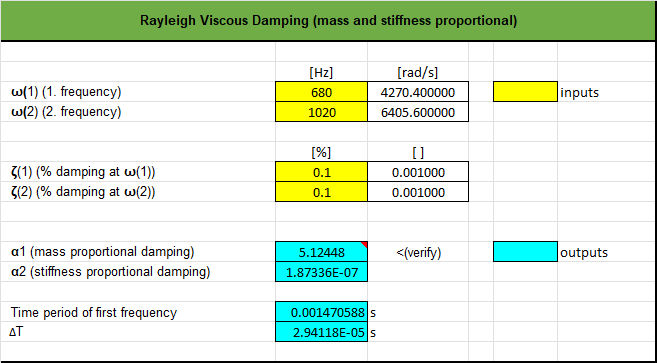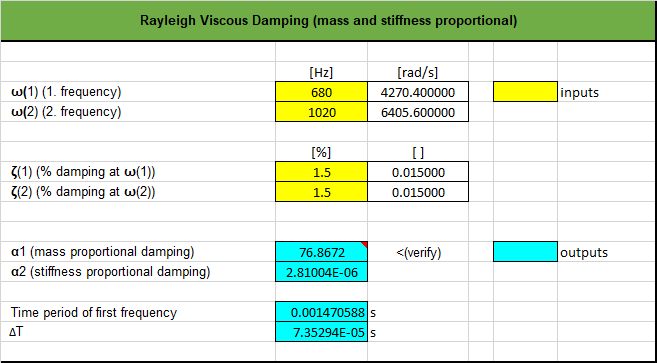-
-
November 9, 2021 at 8:10 pm
DoodlerD
SubscriberPardon me, this question has been asked before, but the answers are not clear.
Going by some text and convention, sudden loads in a transient analysis should result in higher stress levels than a static analysis. However, in my case, the results for a static analysis are higher. Could it simply indicate higher/erroneous damping?
My approach (for a 4 ms over-pressurization event) is as follows:
- Modal analysis (mode participation factor) to get the lowest frequency/mode shape, since it is most likely to cause vibration.
- Run a static analysis with appropriate boundary conditions (Large deflections on, material nonlinearity)
- Use Rayleigh damping and calculate mass/stiffness coefficients based on a frequency range that captures the first two fundamental freq. with 1.5% damping
- Run a transient analysis with appropriate boundary conditions (Large deflections on, material nonlinearity) with max time step that is 1/20th the time period of the lowest freq.
Thank you
@peteroznewman ,@SandeepMedikonda , do you have some tips?
Here's my modal data that drives the transient analysis:
November 16, 2021 at 4:35 pmSean Harvey
Ansys Employee
Two things come to mind. Yes, the damping, so I would suggest dropping it lower and seeing if that is the contributing factor. Second is even though you expect the most response from the lowest frequency, I would try and reduce your max time step further to make sure you are not missing the peak. I have seen transient results reported that were erroneous because the time step was too large. Let us know if this helps.
Regards Sean
November 17, 2021 at 10:32 pmDoodlerD
SubscriberSean,
Thank you for the feedback. I repeated the analysis with the following settings:
 I significantly reduced damping to 0.1% and time step to T/50 instead of T/20. The results remained unchanged. I suppose this occurs because the thick shaft does not generate a strong response due to high material damping.
I significantly reduced damping to 0.1% and time step to T/50 instead of T/20. The results remained unchanged. I suppose this occurs because the thick shaft does not generate a strong response due to high material damping.
November 18, 2021 at 6:20 pmSean Harvey
Ansys Employee
Thinking about this further and your statement "sudden loads in a transient analysis should result in higher stress levels than a static analysis". I would say "should" would not necessary be the word I would use. It can be the case that the duration of the impulse is not long enough to produce a response. But in your case it does seem the duration would be. Have you tried to see that if you expand your pulse to say double the duration, if you get an increased response? Not saying we change the problem statement, but to identify the influence. Also, comparing the deformations at the time = .002 s, are you seeing you are still much less than the static deflection, this can help provide insight by making this comparison.
Regards Sean
November 24, 2021 at 2:24 pmDoodlerD
SubscriberThank you for the response and feedback,
I repeated the simulation with double the time period of the impulsive force, and the results are the same. I'm summarizing my thoughts here for brevity:
The model has a high first fundamental mode ~ 700 Hz so it is less likely to have a strong response. Usually, I've seen models with low first natural modes of vibration (~ 10-20 Hz) generate a strong response to an impulsive load.
The pressure curve is actually a short spike and is being approximated as a sawtooth function for simplicity
Lowering or absence of damping should yield a stronger response for a conservative estimate, which is not resulting in any change in my case
Increasing or decreasing the time duration of the pressure impulse has no effect on the model
November 24, 2021 at 2:44 pmDoodlerD
SubscriberThank you for the nudge in the right direction. I repeated the simulation with and increase pressure wave duration as you suggested, but the results are similar to my previous attempts. I'm summarizing my thoughts for brevity.
The first fundamental frequency is quite high ~ 700 Hz. Mostly, the model is not generating a response due to internal mass damping
The pressure curve is simplified as a sawtooth wave rather than a true impulsive peak for simplicity
Lowering or absence of damping should result in the most conservative design approach
An underdamped model with low first fundamental mode of frequency (5-20 Hz)is more likely to generate a strong transient response, assuming the time-step is correctly set
Viewing 5 reply threads- The topic ‘Transient Vs Static Loading’ is closed to new replies.
Innovation SpaceTrending discussions- The legend values are not changing.
- LPBF Simulation of dissimilar materials in ANSYS mechanical (Thermal Transient)
- Convergence error in modal analysis
- APDL, memory, solid
- How to model a bimodular material in Mechanical
- Meaning of the error
- Simulate a fan on the end of shaft
- Real Life Example of a non-symmetric eigenvalue problem
- Nonlinear load cases combinations
- How can the results of Pressures and Motions for all elements be obtained?
Top Contributors-
4167
-
1487
-
1338
-
1172
-
1021
Top Rated Tags© 2025 Copyright ANSYS, Inc. All rights reserved.
Ansys does not support the usage of unauthorized Ansys software. Please visit www.ansys.com to obtain an official distribution.
-
The Ansys Learning Forum is a public forum. You are prohibited from providing (i) information that is confidential to You, your employer, or any third party, (ii) Personal Data or individually identifiable health information, (iii) any information that is U.S. Government Classified, Controlled Unclassified Information, International Traffic in Arms Regulators (ITAR) or Export Administration Regulators (EAR) controlled or otherwise have been determined by the United States Government or by a foreign government to require protection against unauthorized disclosure for reasons of national security, or (iv) topics or information restricted by the People's Republic of China data protection and privacy laws.












